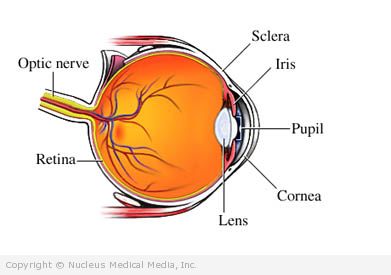Glaucoma – Definition
Glaucoma is a group of diseases that can damage the eye’s optic nerve and result in blindness. One type of glaucoma, called open-angle glaucoma, is often associated with increased pressure inside your eye. This can lead to vision loss or even blindness. This fact sheet focuses on open-angle glaucoma, the most common form of the disease.
Glaucoma – Causes
At the front of the eye, there is a small space called the anterior chamber, which lies between the lens and the cornea. Clear fluid flows in and out of the chamber to bathe and nourish nearby tissues and to keep the eye properly formed. In some cases of glaucoma, for still uncertain reasons, the fluid drains too slowly out of the eye. As the fluid builds up, the pressure inside the eye rises. Unless this pressure is controlled, it may cause damage to the optic nerve and other parts of the eye, leading to vision loss.
Glaucoma – Risk Factors
A risk factor is something that increases your chance of getting a disease or condition.
Risk factors for glaucoma include, but are not limited to:
- Age: over 40 years old
- Race: Black or Hispanic
- Family members with glaucoma
- Having diabetes
- Having hypertension ( high blood pressure)
Note: Risk factors for other forms of glaucoma may differ from these.
Glaucoma – Symptoms
At first, glaucoma usually causes no visual symptoms. Vision stays normal and there is no pain. However, as the disease progresses, peripheral vision gradually begins failing. That is, objects in front may still be seen clearly, but objects to the side may be missed. As the disease worsens, the field of vision narrows and complete blindness can result. Glaucoma is usually a slowly progressive disease, causing damage over many years before obvious symptoms occur.
Glaucoma – Diagnosis
An ophthalmologist or optometrist can often detect glaucoma during an eye examination. One important part of an eye examination to check for glaucoma and other diseases is to dilate your pupils. To accomplish this, drops are put into your eyes during the exam to enlarge your pupils. This allows the eye care professional to see more of the inside of the eye.
To detect glaucoma, your eye care professional will do the following tests:
- Visual acuity — measures how well you see at various distances
- Visual field — measures your side (peripheral) vision
- Tonometry — determines fluid pressure inside the eye
- Pupil dilation — provides a better view of the optic nerve to check for signs of damage
Glaucoma – Treatment
Although open-angle glaucoma cannot be cured, it can often be controlled.
Treatments may include:
Medications
These may be eye drops, eye ointments, or pills. Some drugs are designed to reduce pressure by slowing the production of fluid into the eye. Others help improve fluid drainage.
For most people with glaucoma, regular use of medications will control the progression of damage by lowering eye pressure. However, these drugs may stop working over time, may cause side effects, or may not be effective enough to control the progression of damage. If a problem occurs, your eye care professional may select other drugs, change the dose, or suggest other ways to deal with the problem.
Common glaucoma medications include:
- Drugs that decrease the production of intraocular fluid:
- Beta-blockers — Timolol, Levobunolol, Carteolol
- Carbonic anhydrase inhibitors (CAI) — Acetazolamide, Neptazane, Brinzolamide, Dorzolamide
- Combination CAI/beta-blocker — Cosopt
- Drugs that increase the drainage of intraocular fluid:
- Miotics — (rarely used) Carbachol, Ocusert Akarpine, E-Pilo-1
- Prostaglandin — Bimatoprost, Latanoprost, Travoprost
- Drugs that may decrease production and increase drainage of intraocular fluid:
- Sympathomimetic alpha-adrenergic agonist — Brimonidine, Apraclonidine
- Sympathomimetic nonselective — (rarely used) Epinal, Glaucon, Dipivefrin
Laser Surgery
During laser surgery, a strong beam of light is focused on the part of the anterior chamber where the fluid leaves the eye. This can help fluid exit the eye. Over time, the effect of laser surgery may wear off. Patients who have this form of surgery may need to keep taking glaucoma drugs.
Conventional Surgery
Surgery also can help fluid escape from the eye and thereby reduce pressure. However, surgery is usually reserved for patients who continue to progress despite maximum therapy with eye drops, pills, or laser surgery.
Observation
In some cases, if there is no decrease in the visual field, the patient and physician may decide not to treat glaucoma. Since glaucoma is a very variable disease, treatment decisions are made on an individual basis. In some instances, it may be difficult to diagnose glaucoma. Many people have some signs of the disease but do not necessarily have the disease. Therefore, some physicians decide to monitor patients as “glaucoma suspects” instead of committing them to treatment. Treatment is often initiated once changes consistent with glaucoma are detected.
Glaucoma – Prevention
There are no guidelines for preventing glaucoma.
Early detection and treatment of glaucoma, before it causes major vision loss, is the best way to control the disease. Since vision loss is gradual and begins only in peripheral vision, most patients don’t notice any visual changes until significant damage has been done.
Have regular eye examinations including having your pupils dilated. This is especially important if you are at high risk for glaucoma.

